Vickers Wellington, T2506, Cloonwhite, Co. Clare, 1941
Early on the morning of 25th October 1941, there arrived in the
skies over Ireland a Wellington bomber of the Royal Air Force
carrying a Canadian airman who provided the earliest public
information about the 'fate' of Allied and German airmen
interned in Ireland.
A report prepared on October 27th, 1941 by the Major J P
O'Connell of the Irish Army Intelligence Staff of Southern
Command recorded the following: "In
confirmation of my telephone messages of the 25th, instant,
I have the honour to inform you that a British twin-engined
Wellington bomber crashed in the vicinity of Cahermurphy,
two miles N.W. of Kilmihil, at 08.55 hours on 25th.
The crew consisted of six, two officers and four
N.C.O.'s. They had been on a bombing raid over Germany
and on the return journey got lost, flying acorss England
into Eire. When in Eire they discovered that they were
running out of petrol and the crew with the exception of one
decided to bale out. The member of the crew remaining,
an officer, Keefer, who appeared to be in charge endeavored
to bring the 'plane out to sea where he intended crashing
her, but as she began loosing height he also decided to bale
out. They were picked up in the vicinity of Quilty and
brought to Limerick Military Barracks and were later
transferred to the Curragh.".
After providing the names, addresses and next of kin of the six
crew members, he continued:
The latter three refused to give any
further particulars stating that they would furnish such
information only to their representative in Eire.
Keefer seemed to be in charge and Sergeant Dalton Wireless
operator.
'They had been over Germany twice during the day and night
and came to Eire around 07.00 hours. Keefer stated that they
got false wireless signals in Eire.
The ‘plane crashed on its tail and a guard was placed on
it. There were no bombs. The plane is now being
salvaged by the Air Corps.
Subjoined is a list of articles collected so far;—
2 Silk Parachutes with harmess.
2 sets Parachute harness (one
attached to Flying Jacket ) .
1 Airmen's Flying Suit
1 Airman’s Boot.
2 Mae West Jackets.
Diaper, Calder and Keefer were the three that provided only their names, rank and serial number to the Irish officer.
A further report summary on an undated sheet mentions
that: "A British Wellington
Bomber aircraft crashed at about 07:30 hrs on the 25th
October at Clonwhite, 2 miles north-west of Kilmihil, Co.
Clare. The aircraft was completely destroyed but the
six occupants escaped safely by parachute and were
subsequently taken into custody and interned."
Among the pages in the Irish Army report is a sketch map
highlighting the field in which the aircraft crashed and this
location can be matched to the middle of Cloonwhite South
townland.
This report again provided names, addresses and next of kin, this time for all six men, and went on to describe where theybluestacks had landed by parachute:
The first four airmen came down in the
following areas, one at Doolough (Sgt Brown), one at
Drummin (Sgt Diaper), two at Knocknahila (Calder Keefer),
(S.W. of Drummin) and were taken into Garda custody at
Quilty Garda Barracks.
The 2 last
mentioned N.C.Os. (Virtue and Dalton) landed at Cahirmurphy
and were taken into Garda custody at Kilmihil Garda
Barracks. All six airmen were handed over to military
custody at approximately 15.00 hrs. and conveyed to
Sarsfield Barracks, Limerick.
The airmen left Limerick at 19.30 hrs. for the Curragh,
where they were interned at 23.30 hrs.
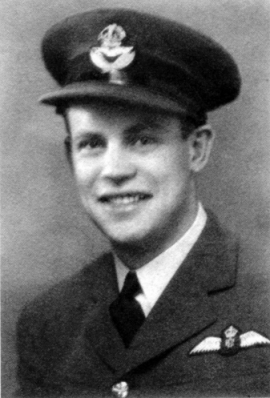 P/O Ralph 'Bob' Gardner KEEFER J/4876 RCAF |
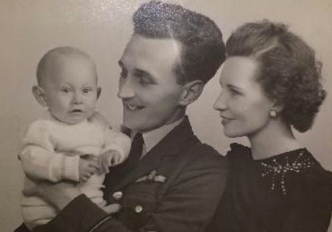 Sgt Leslie George DIAPER 1375190 |
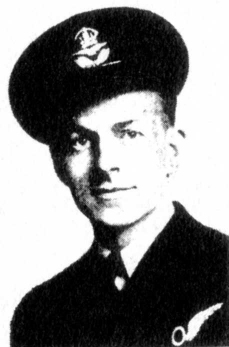 P/O John 'Jack' Philip CALDER J/4695 |
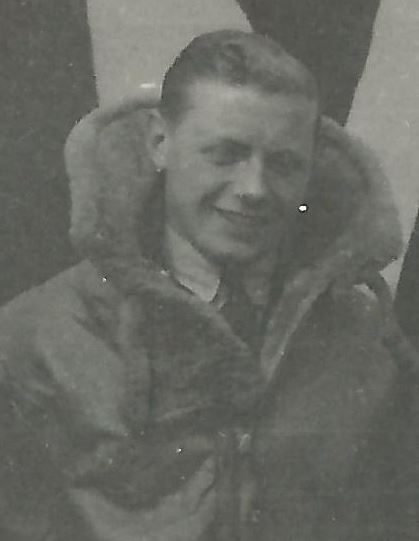 Sgt Albert Colin DALTON 636611 |
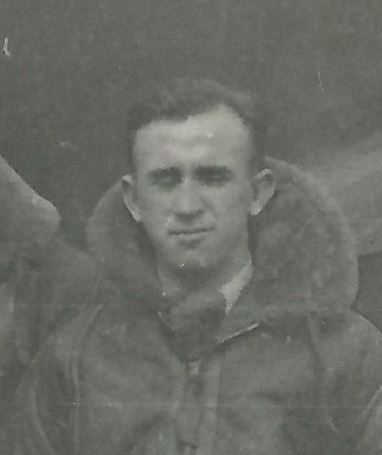 Sgt Maurice Bertram BROWN 987421 |
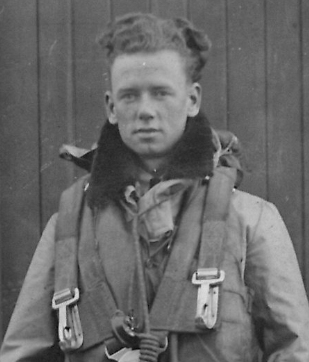 Sgt Alexander VIRTUE 1378792 |
 P/O
Ralph Gardner Keefer was posted in to 103 Squadron on 2
July 1941. He initially flew as second pilot to F/Lt Ball and
his first mission was 24th July 1941 against the German warship,
Gneisenau, at Brest. Ralph escaped from internment on the 17th
August 1942 alone with two other airmen, making his way
northward to the border with Northern Ireland with the aid of
some sympathetic Irish helpers. He returned active service
and flew with Ferry Command in Dorval for a number of months as
an instructor and check pilot. Finally he was posted back
to Europe and was posted to 540 Squadron flying photo
reconnaissance missions until the wars end.
P/O
Ralph Gardner Keefer was posted in to 103 Squadron on 2
July 1941. He initially flew as second pilot to F/Lt Ball and
his first mission was 24th July 1941 against the German warship,
Gneisenau, at Brest. Ralph escaped from internment on the 17th
August 1942 alone with two other airmen, making his way
northward to the border with Northern Ireland with the aid of
some sympathetic Irish helpers. He returned active service
and flew with Ferry Command in Dorval for a number of months as
an instructor and check pilot. Finally he was posted back
to Europe and was posted to 540 Squadron flying photo
reconnaissance missions until the wars end.
He turned to commerce after the war and planned to publish his
memoirs and in the process of doing so, contacted many of his
old internee friends. Sadly, deteriorating health
prevented him from publishing, however his son completed the
work and published it in 2001, under the title "Grounded in
Eire" Ralph Keefer passed away on 28 July 2012.
Leslie George Diaper was born in London in December
1920. His parents were Joy Maud (nee Oliver) and Albert Thomas
Diaper. He grew up in Lewisham, London and worked as a Cashier
before he began his Royal Air Force Service on the 14th August
1940. Trained as a pilot, he ended his training at 15
Operational Training Unit before serving with 103 Squadron. His
flight on the 24th of October 1941 was only his fourth mission
as second pilot with Keefer. During his time interned in the
Curragh Camp, he met and married Jessica M Black from
Brownstown, in 1943 in Kilcullen. They later had a son born in
Dublin just after the war. The family moved to London and lived
in Lewisham. Jessica passed away in 1966. Leslie later died in
the summer of 1992 in his native Lewisham.
His escape and evasion report reads:
We took off from ELSHAM WOLDS in a
Wellington aircraft on 24 Oct 41 at 2000 hrs on a bombing
trip to FRANKFURT. After we left the target the wireless was
unserviceable. At approximately 0530 hrs on 25 Oct we got a
wireless bearing which the navigator plotted. His fix
indicated that we were over EIRE. We were short of petrol,
and the pilot gave the order to bale our as approximately
0615 hrs.
I bailed out and landed near QUILTY, Co. CLARE, EIRE. I was
arrested by the police and interned at the CURRAGH Camp
until 16 Oct 1943 and at GORMANSTOWN until 5 Jun 44, when I
was sent to the U.K.
I was concerned in the tunnel attempt started in Dec 43
which has been described by P/O Tisdall in his report.
Leslie, along with Maurice Brown had the prolonged stay in
internment due their having been on a operational mission at the
time they landed in Ireland. It was only after much contact
between the two governments that they were released in June 1944
from the new internment camp in Gormanstown.
John Phillip Sargant Calder was born in Regina, Saskatchewan to Archibald and Mary Agnes Calder. He was formerly on the editorial staff of The Canadian Press in Toronto. His name can be found on numerous prewar sports reports in Canadian papers. He was trained as a Navigator, that role then carrying the name of Observer.
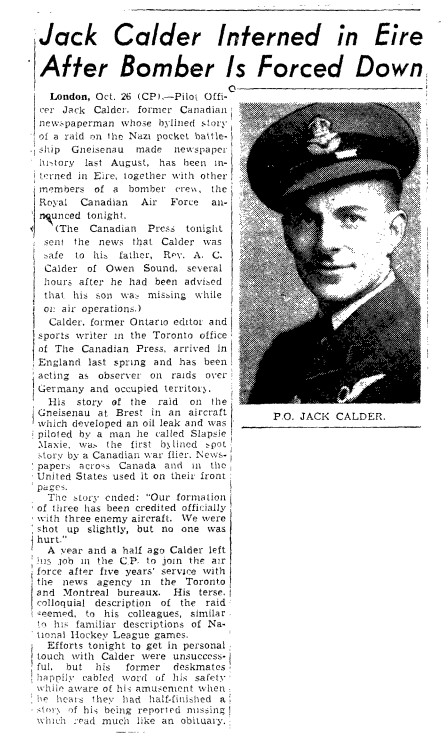 P/O J P Calder was posted in to 103
Squadron in 28 June 1941 and sent on a parachute course to
Weeton. First mission was with F/Lt Max on 20th July. Upon
reaching England however, he was able to continue reporting by
describing some of his experiences. These news stories were
carried by newspapers all over Canada and also the United
States. It began in late April 1941, with a story not by him,
but about him. He was one of a party of Canadian airmen visiting
Windsor Castle when he was asked by the Queen how many men had
been on the vessel he crossed the Atlantic on. Following from
this his recounting of his mission against the port of Brest on
the 24th July 1941, was the first bylined spot story by a
Canadian war flyer. Newspapers across Canada and in the United
States used it on their front pages. This was published on and
around the 30th of October, 1941, coinciding with his internment
in Ireland. His name was next published when news was received
that he was interned in Ireland. His time interned is recorded
by Ralph Keefer’s book, “Grounded in Eire’. While interned Jack
was able to continue reporting and had a number of articles
about internment and his interpretation of neutral Ireland
published in Canadian newspapers.
P/O J P Calder was posted in to 103
Squadron in 28 June 1941 and sent on a parachute course to
Weeton. First mission was with F/Lt Max on 20th July. Upon
reaching England however, he was able to continue reporting by
describing some of his experiences. These news stories were
carried by newspapers all over Canada and also the United
States. It began in late April 1941, with a story not by him,
but about him. He was one of a party of Canadian airmen visiting
Windsor Castle when he was asked by the Queen how many men had
been on the vessel he crossed the Atlantic on. Following from
this his recounting of his mission against the port of Brest on
the 24th July 1941, was the first bylined spot story by a
Canadian war flyer. Newspapers across Canada and in the United
States used it on their front pages. This was published on and
around the 30th of October, 1941, coinciding with his internment
in Ireland. His name was next published when news was received
that he was interned in Ireland. His time interned is recorded
by Ralph Keefer’s book, “Grounded in Eire’. While interned Jack
was able to continue reporting and had a number of articles
about internment and his interpretation of neutral Ireland
published in Canadian newspapers.
In the end, following a number of failed escape attempts Jack
decided with the aid of others to feign a mental breakdown in
order to obtain a release on medical grounds. This attempt
proved successful and he was released on the 2nd of July 1943.
He soon returned to flying duties but was badly injured in a
crash on 9th August 1943 when the Anson aircraft he was flying
in crashed in Yorkshire. The crash is discussed on the Aircraft Accidents in Yorkshire
Website.. He was listed as dangerously ill until the 12th
August 1943 but subsequently made a full recovery.
Jack Calder's luck ran out on the night of 20th/21st July 1944
while flying a mission to Hamburg with 571 Squadron. He and his
pilot on the night, F/Lt D L Thompson, had only been
posted into the Squadron on the 17th July. Flying first
and only operational mission, their Mosquito ML984, was hit by
flak, injuring Jack in both legs. He bailed out of the aircraft
ahead of the pilot but was wearing only his Mae West. Nothing
more was heard of him until after the war when British Missing
Research and Enquiry Service teams discovered that his body had
been recovered and buried in Brunsbuettelkoog, on the north
shore of the mouth of the Elbe River in September 1944. This
discovery was made in 1949 and conveyed to his parents. Jack's
two brothers had served overseas with the Canadian Army.
Jack is buried in Kiel War cemetery.
Albert Colin Dalton was the radio operator on T2506. He
was born in North Anston, near Sheffield on the 11th of November
1921.
His first 103 Squadron mission was with P/O Ball on 10 May 1941
against Emden when their Wellington, serial R1395, was attacked
by numerous aircraft and damaged. His baptism of fire
ended up in a wheels up forced landing. His early missions
were flown under the command of New Zealander, F/O Edward C
Ball. The photos below supplied by Colin's nephew, show
this earlier crew:
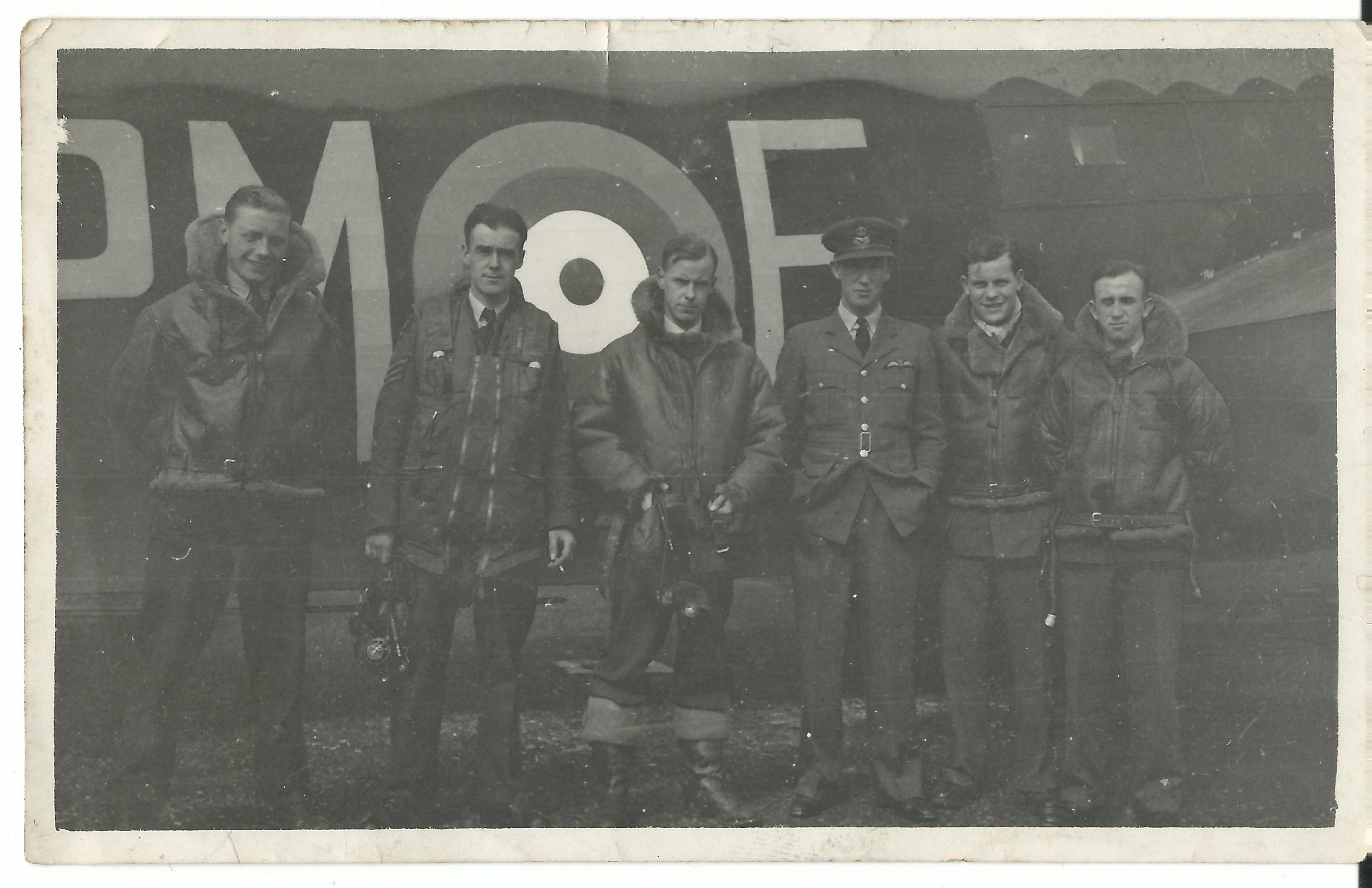
The photo above shows, Standing in line: Left to Right:
Sgt A C Dalton, Sgt.'s Tett and Cox, F/O E C Ball RNZAF, R
Keefer RCAF, and of course M B Brown.

The photo above shows, Standing in line: Left to Right: Sgt Tett, F/O E C Ball RNZAF, M B Brown, with sitting at the front, Left to right, Sgt Cox, Sgt A C Dalton and R Keefer RCAF.
Colin's log book records the 25th October 1941 operation that
ended in Co. Clare and shows that the flight lasted 9 hours and
20 minutes.
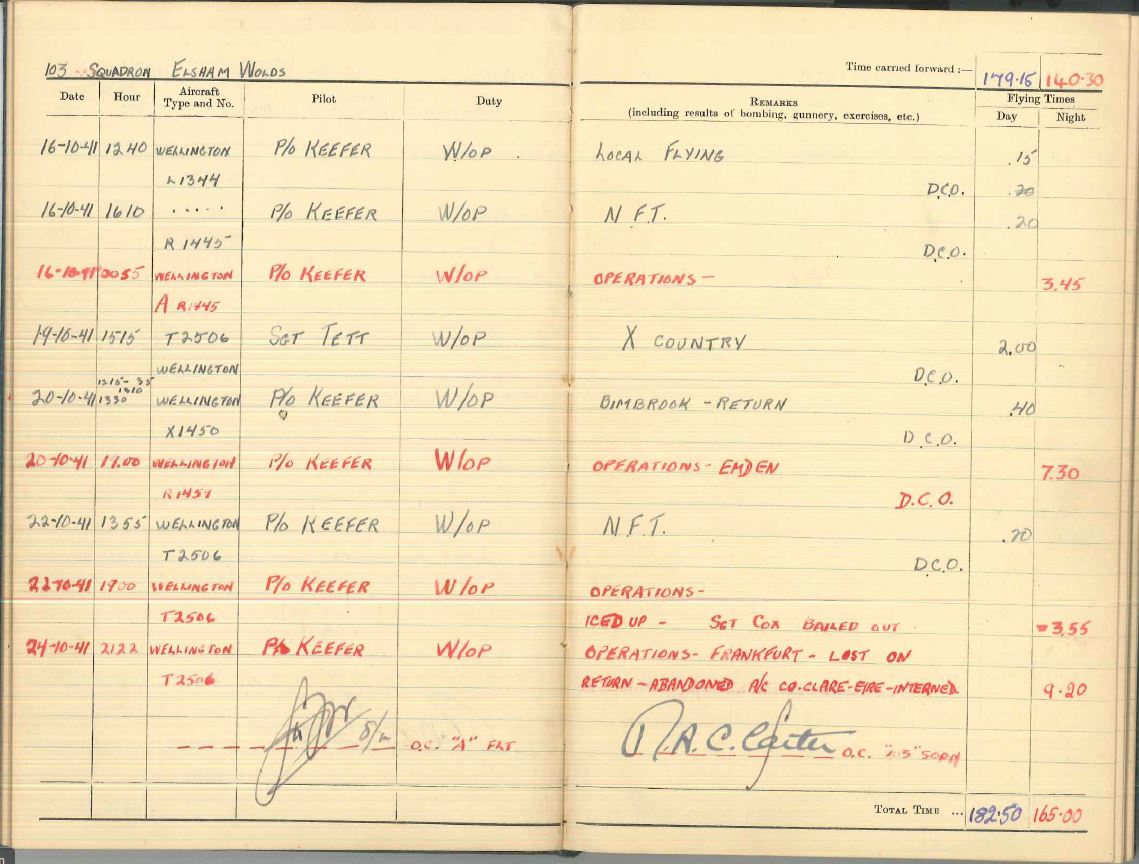
While interned, Colin submitted a claim for and was awarded his
Caterpillar Badge by the Irvine parachute company for having had
a successful bail out. Of interest is the address at which
he was sent the letter, "RAF Internee, Curragh, Camp, Co.
Kildare, EIRE". The modern day company was able to confirm
that all members of the crew requested and received their
caterpillar badges.
Sgt Dalton was able to make an escape from the camp in September 1942 when another internee forged his signature on a parole form. He was posted to 75 Opeartional Training Unit (OTU), which was at that time UK based prior to moving to the Middle East. In January 1943, he was next posted to 30 OTU and then on to 156 Squadron in April 1943, where he served until his death in September of that year.
Sgt Dalton returned to active duty and flew his first mission with 156 Squadron on the 26 April 1943. On the 7th September 1943 when flying on Lancaster JB177 on his 21st bombing raid, he was shot down by a German nightfighter. Dalton was killed along with three other members of the crew. Aged just 21, he is buried in the CWGC cemetery in Durnbach, Germany. At the time of his death, his parents Albert and Mabel (nee Turner) lived in Dinnington.
Maurice Bertram Brown came from Middlesborough, born in
1913 to Sarah and Bertie Brown. In the 1939 register he is found
living with his mother and working as a Clerk.
He was the front gunner on T2506 and had been in the RAF since
the summer of July 1940. He may have flown his first mission
with Sgt Munro on 17 June 1941. During his time being interned,
he met and married Bridget Devin. They were married in the
Autumn of 1942. Like Sgt Diaper, Maurice was required to remain
interned after the initial batch of airmen were released in
October 1943 and was moved to the Gormanstown Camp. He was
returned to the United Kingdom in June 1944.
He returned to Middlesborough after the war, with Bridget
following him a little later. He got work with the ICI
company and through this was able to get a transfer to Ireland
and the family settled in Chapilizod. He corresponded
briefly with Ralph Keefer in 1985 and passed away on the 5th of
April 1988. He is buried in Palmerstown Cemetery, Dublin.
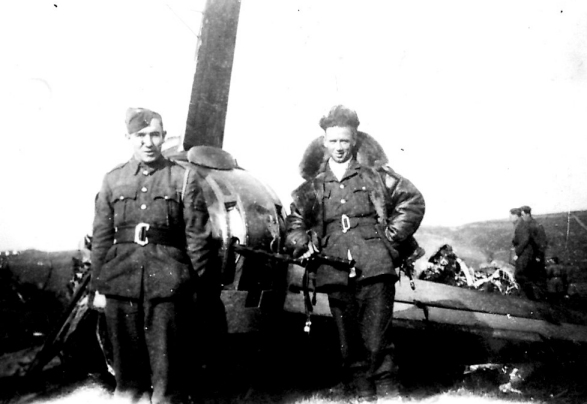 Alexander Virtue came from Newcastle upon
Tyne and was born to Alexander and Jane Virtue. The October
22nd/23rd mission was for Alexander his first mission as gunner
with P/O Calder's crew and indeed with 103 Squadron. He was
appointed to the crew after Calder's previous rear gunner
accidentally baled out of their aircraft over Europe. In
the aftermath of the crash, Alex was photographed with local
garda and military standing next to the wreckage of T2506
Alexander Virtue came from Newcastle upon
Tyne and was born to Alexander and Jane Virtue. The October
22nd/23rd mission was for Alexander his first mission as gunner
with P/O Calder's crew and indeed with 103 Squadron. He was
appointed to the crew after Calder's previous rear gunner
accidentally baled out of their aircraft over Europe. In
the aftermath of the crash, Alex was photographed with local
garda and military standing next to the wreckage of T2506
Alex was repatriated from Ireland to the UK in March 1943 for
medical reasons. He passed away in RAF Princess Mary Hospital in
Halton Camp on the 10th of June, 1944 just five days before his
two remaining crew mates from T2506 were released from the camp
in Gormanstown.
He left two infant sons who have been very helpful in building
up this webpage in his and his crew mates memory. His widow Jane
had the following inscription added to his Commonwealth War
Graves Commission headstone, "In proud and loving memory of my
darling husband Alec "Till we meet again"".
Wellington T2506 was a Vickers Wellington mark Ic, the first
major production version of the Wellington. Photos of the
aircraft wreckage have been widely printed over the years and
often appear on social media.
